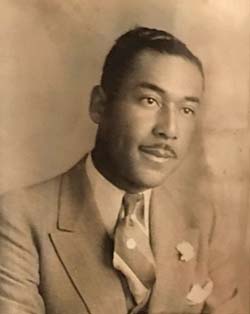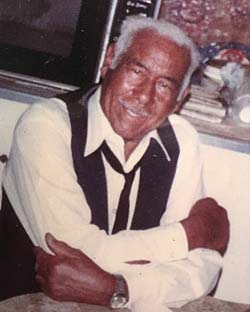|
The Lorenzo Anderson House in Otay
The Anderson house on Main Street in Otay is Chula Vista Historic Site #68
Anderson house historic site application May 24, 2005
NBC7 news story on 1916 flood and Anderson house Feb. 26, 2016 1891/07/21 The 3487 Main Street House is of the Victorian period on 6 acres south of Main Street Otay. It is of a style commonly known as an Orchard House On early plat maps there is a dairy barn and packing shed with indications of an orchard at the front of the property and possibly field crops and animal pens at the rear. An early photograph July 21,1891 identifies the house as Mr. Isaac Smiths residence. There is a horse and buggy in the yard and Main Street is shown as a narrow path Owners in the 1920 s included a German family George and Lisbeth Schurig who operated a dairy. ( Agenda Packet 2005/05/24, City of Chula Vista Historic Designation Application, Anderson House, 3487 Main Street. ) 1920 - The Schurig dairy was operated in the 1920s by a German family George and Lisbeth Schurig on the Anderson house property. The 3487 Main Street House is of the Victorian period on 6 acres south of Main Street Otay It is of a style commonly known as an Orchard House. On early plat maps there is a dairy barn and packing shed with indications of an orchard at the front of the property and possibly field crops and animal pens at the rear. An early photograph July 21,1891 identifies the house as Mr. Isaac Smiths residence. There is a horse and buggy in the yard and Main Street is shown as a narrow path. ( Agenda Packet 2005/05/24, City of Chula Vista Historic Designation Application, Anderson House, 3487 Main Street. ) In this 1928 aerial photo of Otay, #1 is the Schurig dairy, later the site of the 6-acre Anderson house property; #2 is the small brick Clark house and post office at 3148 Main St. that survived the flood and is Chula Vista Historic Site 75; #3 is the Otay school built 1925 on the site of the 1889 school and is the site of today's John J. Montgomery school; #4 is the 3-story brick building that was built in 1889 as the Otay Watch Factory; #5 is the Otay Baptist Church built in 1890 on the southwest corner of Third and Zenith, then moved after the 1916 flood to the northeast corner.
1936/05/22 - "Andrew White, 104, Civil War Vet, Dies Unexpectedly On Otay Ranch. On Jan. 1. 1832, a Negro boy was born in Cuba. They christened him Andrew White. Last Saturday, on a neat little ranch near Otay, a friendly old Negro, known throughput the South Bay district as Andrew Jackson, expired. He was 104 years old. For 10 years, Andrew White or Andrew Jackson had resided near here. Time and again, his pictures had appeared in metropolitan newspapers. For Andrew was news. Especially in November of last year. That was when he decided to retire, to take things easy in his declining years. So he turned over the care of his ranch and the responsibility of raising 30 head of hogs to Robert Armstrong and A. G. Stephenson. He was in the best of health then. Carefully he made out the lease. It was to run for three years. And at the expiration of that period, he commented when he signed the instrument, he hoped to be able to renew the lease. But death struck swiftly, unexpectedly. It was 1:30 a. m. Dr. Parker Hollingsworth attended him. And on the death certificate the cause was listed as cerebral hemorrhage. Ninety years ago, Andrew White came to the United States. He was 14 years old. Gold hadn't been discovered in California. The Civil war still was 16 years distant. When hostilities did start, Andrew White enlisted. He served with the confederate forces, a colorful figure in his tattered clothes, a friendly Negro who became known as Andrew Jackson. Forty years ago, he came to California. About 10 years ago, he said a short time before his death, he got what he described as his second eyesight. And until the time he expired the finest newspaper print was not too small for Andrew White to read without the aid of glasses. His body was taken to Tate's Funeral home, 3109 Ocean View blvd., San Diego. Wednesday, he was buried at Holy Cross cemetery. A Catholic priest officiated." ( Chula Vista Star, May 22, 1936. )
1939 - Lorenzo Anderson was a young African American road worker for the county in the 1930s. He decided to move from Logan Heights to Otay Valley, buying the old orchard house at 3487 Main Street that had been built in 1888. The house is Chula Vista Historic Site #68. ( Agenda Packet 2005/05/25, City Council Minutes. ) 1939 - Lorenzo Anderson worked for the county road dept, saw many rural parts of the area. He decided to move from inner-city Logan Heights to the rural area of Otay Valley where he bought a farm and lived with his wife Louise Anderson and raised 3 children: daughter Barbara Anderson attended SDSU and received BS degree in 1954, then to Kansas State Teachers College for MS in library science. ( Wilkin, Binnie Tate, ed. African American Librarians in the Far West: pioneers and trailblazers. Lanham, MD: Scarecrow Press, 2006. )
The Woodlawn Park Church of God in Christ at 124 Spruce Road was built in 1940 by Will and Menzie Wallace who moved to Woodlawn Park in 1932 and lived at 1655 Sycamore on their 6-acre hog ranch. Woodlawn Park was founded in 1910 by the Broderick-West Land Co. as "the most artistic laid out tract in the state, in a park having over four miles of beautiful drives, all lined with trees, nine small and highly improved parks, eight cobblestone entrances and a small lake, and located where you get the balmiest climate San Diego affords" (San Diego Union, June 23, 1910). But after the 1916 flood, the subdivision failed and during the Great Depression offered seclusion and cheap land for Black Americans such as the Wallaces.
1964/08/06 - Will Wallace of Woodlawn Park in Otay, is the local fire district that protects the rural community of 25, the fire station is a building that was the store his wife Menzie ran. The fire truck was built by La Mesa Fire Capt England T. Robeson. Will's assistant is Hayes White of 173 Lotus Drive. Other volunteers are Mack Robson, Amos Lee Hall, Jr., Daniel Powell, Otis Galberth, John Whiting, Darphelia Robson. The fire district was organized Jan. 17, 1953. Percy H. Steel, Jr. head of Urban League in SD was honorary member. Will operates a 6-acre hog ranch with 40 swine, picks of garbage everyday in SD to feed the hogs. But the graded hills nearby indicated CV city limits "closing in around." Menzie is the founder of the Woodlawn Park Chuch in Christ, a small white building. They were married 1928 in Texas, came to San Diego 1929, did many kinds of jobs, got land in Woodlawn park in 1932. "We were the 12th family to move into Woodlawn Park. All have moved out but two. But we pioneered it on through." Menzie Wallace had heart attack in 1956 just about the time they dedicated the church. ( Chula Vista Star-News, Aug. 6, 1964. ) 1977/08/25 - Woodlawn Park. Squeezed in between San Diego and southeast Chula Vista, this tiny black community has managed to retain its "lived-in" rural flavor, despite urban encroachment. Cattle and horses graze next to rusted-out automobile shells. Chicken wire encloses real chickens. About the only thing missing is the infamous pig ranch. Life is slow, unorganized. Black and brown faces closely watch strange cars. They know who lives in Woodlawn Park and those who don't. The community began in 1910 as a planned wealthy agricultural development. When the Lower Otay Dam broke in 1916, flooding rendered the land unproductive. Cheap land and open space drew many blacks from the South. One old-timer is Mack Robson, deacon in the Woodlawn Park Church of God in Christ, former fire chief and self-proclaimed keeper-of-the-peace. Robson says he's a former deputy sheriff who came to the area in 1941 from Oklahoma. He "kind of liked the place," so he stayed put. "It looked much better then," Robson says, pointing to the decaying frame building which was home for 16 years for the Woodlawn volunteer fire department. "I'd say the place has changed," Robson said, leaning out his truck window, "just about 85%. There wasn't nothing here except that white house over there." Woodlawn Park was good rabbit-hunting grounds, he said, adding, "just over there" he let some 3,000 head of hogs have a run of it in 1945. (Chula Vista Star-News, Aug 25, 1977)
|
|||||
|
Home •
About Us •
Next Meeting •
Latest News •
Resources •
Organizations •
Exhibits •
Bulletins
Contact
|
|||||
|
This web page was created April 15, 2017, and revised April 20, 2016, by Steve Schoenherr for the South Bay Historical Society | Copyright © 2017
|




